 Image 1 of 36
Image 1 of 36

 Image 2 of 36
Image 2 of 36

 Image 3 of 36
Image 3 of 36

 Image 4 of 36
Image 4 of 36

 Image 5 of 36
Image 5 of 36

 Image 6 of 36
Image 6 of 36

 Image 7 of 36
Image 7 of 36

 Image 8 of 36
Image 8 of 36

 Image 9 of 36
Image 9 of 36

 Image 10 of 36
Image 10 of 36

 Image 11 of 36
Image 11 of 36

 Image 12 of 36
Image 12 of 36

 Image 13 of 36
Image 13 of 36

 Image 14 of 36
Image 14 of 36

 Image 15 of 36
Image 15 of 36

 Image 16 of 36
Image 16 of 36

 Image 17 of 36
Image 17 of 36

 Image 18 of 36
Image 18 of 36

 Image 19 of 36
Image 19 of 36

 Image 20 of 36
Image 20 of 36

 Image 21 of 36
Image 21 of 36

 Image 22 of 36
Image 22 of 36

 Image 23 of 36
Image 23 of 36

 Image 24 of 36
Image 24 of 36

 Image 25 of 36
Image 25 of 36

 Image 26 of 36
Image 26 of 36

 Image 27 of 36
Image 27 of 36

 Image 28 of 36
Image 28 of 36

 Image 29 of 36
Image 29 of 36

 Image 30 of 36
Image 30 of 36

 Image 31 of 36
Image 31 of 36

 Image 32 of 36
Image 32 of 36

 Image 33 of 36
Image 33 of 36

 Image 34 of 36
Image 34 of 36

 Image 35 of 36
Image 35 of 36

 Image 36 of 36
Image 36 of 36





































1965 Voting Rights For All Shirt - Short-Sleeve T-Shirt
from $25.00
Voting History
1776: White men aged 21 and older who owned property were granted the right to vote.
Late 18th/early 19th century: Property ownership requirements were gradually removed, extending voting rights to most white men.
African American men
1868: The 14th Amendment recognized African Americans as citizens.
1870: The 15th Amendment granted African American men the right to vote. However, discriminatory practices like poll taxes and literacy tests continued to hinder their participation.
1965: The Voting Rights Act was passed, outlawing discriminatory voting practices and securing the right to vote for African Americans.
Women
1890: Wyoming was the first state to recognize women's right to vote.
1920: The 19th Amendment extended voting rights to women nationwide.
1965: African Americans and other minority groups got the right to vote.
Native Americans
1924: The Indian Citizenship Act, also known as the Snyder Act, granted Native Americans citizenship, although many states still denied them the right to vote.
1947: All states finally granted Native Americans the right to vote. Challenges related to voting access persist for some on reservations.
Residents of Washington D.C.
1961: The 23rd Amendment gave residents of the District of Columbia the right to vote in presidential elections.
This thick cotton t-shirt makes for a go-to wardrobe staple! It's comfortable, soft, and its tubular construction means it's less fitted.
• 100% ring-spun cotton
• Heather Grey is 90% cotton and 10% polyester (all other heather colors are 35% cotton and 65% polyester)
• Fabric weight: 4.3 oz/yd² (145.79 g/m²)
• Pre-shrunk
• Shoulder-to-shoulder taping
• Double-stitched sleeves and bottom hem
• Blank product sourced from Haiti, Honduras, Mexico, or Bangladesh
Disclaimer: Due to the fabric properties, the White color variant may appear off-white rather than bright white.
This product is made especially for you as soon as you place an order, which is why it takes us a bit longer to deliver it to you. Making products on demand instead of in bulk helps reduce overproduction, so thank you for making thoughtful purchasing decisions!
1776: White men aged 21 and older who owned property were granted the right to vote.
Late 18th/early 19th century: Property ownership requirements were gradually removed, extending voting rights to most white men.
African American men
1868: The 14th Amendment recognized African Americans as citizens.
1870: The 15th Amendment granted African American men the right to vote. However, discriminatory practices like poll taxes and literacy tests continued to hinder their participation.
1965: The Voting Rights Act was passed, outlawing discriminatory voting practices and securing the right to vote for African Americans.
Women
1890: Wyoming was the first state to recognize women's right to vote.
1920: The 19th Amendment extended voting rights to women nationwide.
1965: African Americans and other minority groups got the right to vote.
Native Americans
1924: The Indian Citizenship Act, also known as the Snyder Act, granted Native Americans citizenship, although many states still denied them the right to vote.
1947: All states finally granted Native Americans the right to vote. Challenges related to voting access persist for some on reservations.
Residents of Washington D.C.
1961: The 23rd Amendment gave residents of the District of Columbia the right to vote in presidential elections.
This thick cotton t-shirt makes for a go-to wardrobe staple! It's comfortable, soft, and its tubular construction means it's less fitted.
• 100% ring-spun cotton
• Heather Grey is 90% cotton and 10% polyester (all other heather colors are 35% cotton and 65% polyester)
• Fabric weight: 4.3 oz/yd² (145.79 g/m²)
• Pre-shrunk
• Shoulder-to-shoulder taping
• Double-stitched sleeves and bottom hem
• Blank product sourced from Haiti, Honduras, Mexico, or Bangladesh
Disclaimer: Due to the fabric properties, the White color variant may appear off-white rather than bright white.
This product is made especially for you as soon as you place an order, which is why it takes us a bit longer to deliver it to you. Making products on demand instead of in bulk helps reduce overproduction, so thank you for making thoughtful purchasing decisions!
Color:
Size:
Voting History
1776: White men aged 21 and older who owned property were granted the right to vote.
Late 18th/early 19th century: Property ownership requirements were gradually removed, extending voting rights to most white men.
African American men
1868: The 14th Amendment recognized African Americans as citizens.
1870: The 15th Amendment granted African American men the right to vote. However, discriminatory practices like poll taxes and literacy tests continued to hinder their participation.
1965: The Voting Rights Act was passed, outlawing discriminatory voting practices and securing the right to vote for African Americans.
Women
1890: Wyoming was the first state to recognize women's right to vote.
1920: The 19th Amendment extended voting rights to women nationwide.
1965: African Americans and other minority groups got the right to vote.
Native Americans
1924: The Indian Citizenship Act, also known as the Snyder Act, granted Native Americans citizenship, although many states still denied them the right to vote.
1947: All states finally granted Native Americans the right to vote. Challenges related to voting access persist for some on reservations.
Residents of Washington D.C.
1961: The 23rd Amendment gave residents of the District of Columbia the right to vote in presidential elections.
This thick cotton t-shirt makes for a go-to wardrobe staple! It's comfortable, soft, and its tubular construction means it's less fitted.
• 100% ring-spun cotton
• Heather Grey is 90% cotton and 10% polyester (all other heather colors are 35% cotton and 65% polyester)
• Fabric weight: 4.3 oz/yd² (145.79 g/m²)
• Pre-shrunk
• Shoulder-to-shoulder taping
• Double-stitched sleeves and bottom hem
• Blank product sourced from Haiti, Honduras, Mexico, or Bangladesh
Disclaimer: Due to the fabric properties, the White color variant may appear off-white rather than bright white.
This product is made especially for you as soon as you place an order, which is why it takes us a bit longer to deliver it to you. Making products on demand instead of in bulk helps reduce overproduction, so thank you for making thoughtful purchasing decisions!
1776: White men aged 21 and older who owned property were granted the right to vote.
Late 18th/early 19th century: Property ownership requirements were gradually removed, extending voting rights to most white men.
African American men
1868: The 14th Amendment recognized African Americans as citizens.
1870: The 15th Amendment granted African American men the right to vote. However, discriminatory practices like poll taxes and literacy tests continued to hinder their participation.
1965: The Voting Rights Act was passed, outlawing discriminatory voting practices and securing the right to vote for African Americans.
Women
1890: Wyoming was the first state to recognize women's right to vote.
1920: The 19th Amendment extended voting rights to women nationwide.
1965: African Americans and other minority groups got the right to vote.
Native Americans
1924: The Indian Citizenship Act, also known as the Snyder Act, granted Native Americans citizenship, although many states still denied them the right to vote.
1947: All states finally granted Native Americans the right to vote. Challenges related to voting access persist for some on reservations.
Residents of Washington D.C.
1961: The 23rd Amendment gave residents of the District of Columbia the right to vote in presidential elections.
This thick cotton t-shirt makes for a go-to wardrobe staple! It's comfortable, soft, and its tubular construction means it's less fitted.
• 100% ring-spun cotton
• Heather Grey is 90% cotton and 10% polyester (all other heather colors are 35% cotton and 65% polyester)
• Fabric weight: 4.3 oz/yd² (145.79 g/m²)
• Pre-shrunk
• Shoulder-to-shoulder taping
• Double-stitched sleeves and bottom hem
• Blank product sourced from Haiti, Honduras, Mexico, or Bangladesh
Disclaimer: Due to the fabric properties, the White color variant may appear off-white rather than bright white.
This product is made especially for you as soon as you place an order, which is why it takes us a bit longer to deliver it to you. Making products on demand instead of in bulk helps reduce overproduction, so thank you for making thoughtful purchasing decisions!

